Hanfu Craze: What Cultural Phenomena Lie Behind It?

Hanfu craze and the Xitang Cultural Celebration
“Yue silk robes fluttering in the spring breeze, a jade-carved qilin belt glowing red.”
In 2023, the 11th Chinese National Costume Performance and Xitang Hanfu Culture Week was held in the ancient town of Xitang. Over four days and three nights, more than 40 events took place, attracting over 100,000 participants, once again proving the phenomenon of the “Hanfu craze.”
Xitang Hanfu Culture Week has become a grand event in the Hanfu community, drawing enthusiasts of Chinese traditional culture from all over the world to gather and celebrate. Topics such as “Wearing Hanfu to Stroll Through a Jiangnan Ancient Town,” “A Thousand-Year Hanfu Encounter,” and “Experiencing the Beauty of Traditional Chinese Culture Through Calligraphy, Chess, Painting, Poetry, and Tea at Hanfu Culture Week” have frequently appeared on trending searches, underscoring the growing reach of the Hanfu cultural trend.
A recently released report, the “2023 Annual Chinese Cultural Symbol International Communication Index (CSIC),” ranked Hanfu as the 6th most significant symbol of Chinese cultural heritage among the top ten. This demonstrates that Hanfu is becoming a tangible medium connecting modern and traditional culture, sparking a global cultural trend known as ‘Chinese Style’ (中国风).This is a clear indication of why Hanfu is spreading—as it’s increasingly seen as a vital cultural expression connecting the past with the present.
But how has Hanfu, a traditional Chinese attire, evolved from a niche interest into mainstream culture? And what cultural phenomena does the “Hanfu craze” reflect?It’s important to explore the roots of Hanfu cultural trend, which lie in the growing collective appreciation for traditional Chinese heritage, as people seek to reconnect with their cultural identity through clothing. Why Hanfu is spreading can be attributed to both the digital age’s ability to amplify niche interests and the increasing popularity of cultural events that celebrate Hanfu’s beauty and symbolism.

What Is Hanfu?
Hanfu, also known as Hua Fu (华服, “Chinese Clothing”), was recorded in Zuo Zhuan (春秋左传):
“China is known for its great etiquette, hence it is called Xia (夏); it is admired for its beautiful attire, hence it is called Hua (华).”
Since ancient times, Hanfu has embodied people’s unique imagination of sartorial beauty. It is precisely because of this that, despite the complexities of modern society, this traditional Chinese attire—with a history spanning thousands of years—still shines brilliantly.
An Inherent Connection to Traditional Culture
China has long been known as the “Land of Rituals and Etiquette” (礼仪之邦), and this culture of etiquette is deeply ingrained in daily life—including Hanfu.
- In terms of overall style, Hanfu is elegant and modest, reflecting the ancient Chinese virtues of “benevolence, righteousness, propriety, wisdom, and integrity” (仁、义、礼、智、信).
- In terms of historical characteristics, Hanfu has been endowed with rich cultural meanings, with different dynasties and occasions dictating variations in style, fabrics, embroidery, and accessories.
Thus, the saying “Wear the attire of the Han people and uphold the land of propriety” (着汉家衣裳,兴礼仪之邦) aptly describes the beauty of etiquette in Hanfu.
This cultural reverence embedded in Hanfu also highlights the deeper societal trend: the Hanfu cultural trend is more than just a fashion statement; it is an expression of deeper cultural pride and identity.
The Hanfu craze stems from dynastic cultural heritage, worth exploring in depth.
A Deeply Rooted Sense of Cultural Identity
Within the Hanfu community, enthusiasts often refer to each other as “tongpao” (同袍, “fellow robe wearers”), signifying a shared cultural affiliation and identity.
The term “tongpao” first appeared in the Book of Songs (诗经) in the poem “Qin Feng · Wu Yi” (秦风·无衣):
“How can one say we have no clothes? Let us share the same battle robe.”
In that era, soldiers on the battlefield, bound by profound patriotism, stood united and persevered through hardships. Similarly, today, the rise of the “Hanfu craze” reflects people’s collective recognition of the traditional Chinese culture that Hanfu represents.
A Symbol of Contemporary Trends
During China’s modern history, Sun Yat-sen implemented clothing reforms as part of his broader social revolution after founding the Republic of China. At its core, attire is not just about individual appearance—it also mirrors social culture and the spirit of the times.
Thus, the rise of Hanfu is both a revival of traditional Chinese attire and a dynamic expression of contemporary fashion trends.

How Did Hanfu Successfully “Break Out of Its Niche”?
Looking back at the “Hanfu craze,” we can see its journey from a niche hobby to mainstream recognition and eventually widespread acceptance. Enthusiasts who once wore Hanfu only at specific events have now started embracing it in everyday life. Hanfu’s dynastic heritage fuels its modern innovation. Several factors have contributed to this shift:
A Mutual Attraction Between Hanfu and Scenic Spots
Ancient cities and towns, with their authentic historical ambiance, provide a natural setting for Hanfu wearers, enhancing the immersive experience of history and culture.
Conversely, the growing popularity of Hanfu has boosted the visibility of these historical locations. For instance, Xitang Ancient Town has hosted Hanfu Culture Week since 2013, attracting millions of Hanfu and traditional culture enthusiasts. As a result, Xitang has not only become the permanent venue for the event but also earned the title of “Hanfu Capital” (汉服之都).
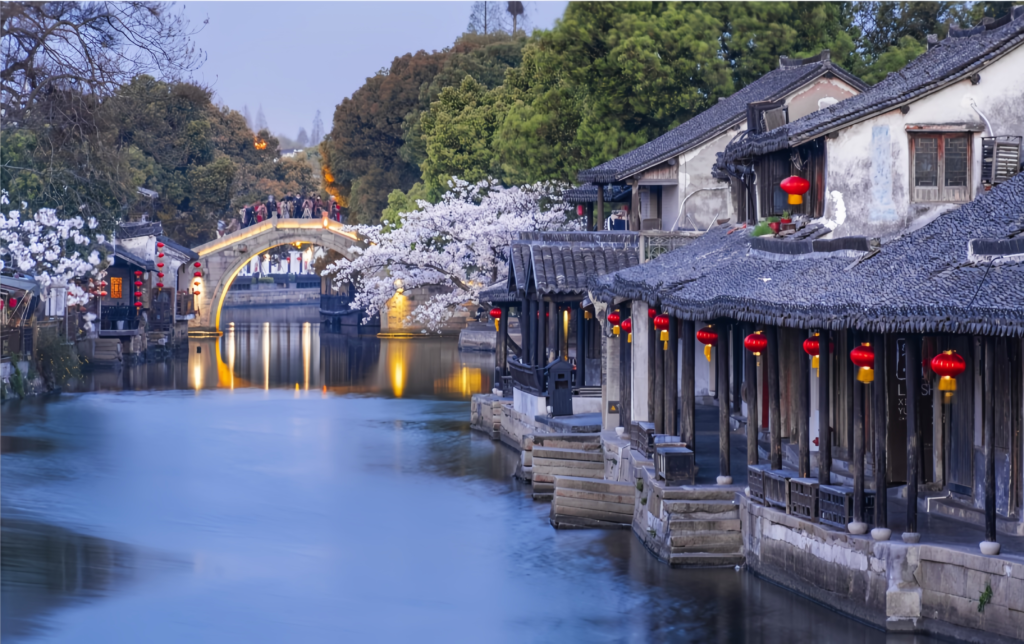
The Intersection of Industry and Passion Creating Economic Value
Thanks to a growing number of young Hanfu enthusiasts, the Hanfu industry is thriving, especially in places like Cao County, Heze, Shandong Province. Known as an internet-famous hub for Hanfu production, Cao County has become a key player in the Hanfu craze. Over the past few years, local businesses have capitalized on the increasing demand for Hanfu by offering high-quality garments that cater to a diverse range of tastes, from traditional styles to more modern adaptations. The success of Hanfu in these regions is also supported by the increasing participation of young designers and artisans who are bringing fresh creativity and innovation to the traditional craft.
Beyond Hanfu design and production, new business models—such as “Hanfu + Culture,” “Hanfu + Marketplaces,” and “Hanfu + Performances”—are emerging. These models are not only expanding the scope of the Hanfu cultural trend but also constantly evolving to meet the growing interest in Chinese traditional culture. For example, “Hanfu + Culture” has led to cultural experiences like tea ceremonies and calligraphy workshops, where participants can immerse themselves in traditional Chinese arts while wearing Hanfu. These cultural events are helping more people connect with the rich heritage of China, all while showcasing the elegance of Hanfu.
The “Hanfu + Marketplaces” model has given rise to online platforms dedicated to Hanfu shopping, where enthusiasts from across the world can easily access a wide range of styles and accessories. With the growing popularity of Hanfu, these marketplaces are providing a convenient way for people to find everything they need to fully embrace the Hanfu cultural trend. Meanwhile, the “Hanfu + Performances” model has opened up opportunities for Hanfu to be featured in cultural performances, exhibitions, and historical reenactments. These events are giving the garment a new life as both a symbol of cultural identity and an art form, further cementing its place in the global spotlight.
The Hanfu cultural trend is not confined to Cao County alone. In other culturally rich cities like Xi’an’s Tang Paradise, Luoyang’s Luoyi Ancient City, and Hangzhou’s West Lake, the Hanfu industry continues to gain momentum. These cities have recognized the cultural and economic potential of Hanfu, integrating it into their tourism industries by hosting festivals, parades, and events that celebrate traditional Chinese attire. As a result, Hanfu has become an essential element of the cultural tourism landscape in these regions, attracting visitors eager to learn about Chinese history while experiencing the beauty of Hanfu firsthand.
With a well-established “Hanfu industry chain” across various cities, from design to retail, from tourism to performance, the foundation for the Hanfu craze is stronger than ever. The growth of this industry reflects not only the increasing demand for Hanfu but also the larger cultural revival taking place in China. As Hanfu continues to be embraced by both the younger generation and international audiences, the Hanfu cultural trend is likely to remain a lasting cultural phenomenon, ensuring that Hanfu will remain a central part of China’s cultural identity for years to come.
Creativity and Media Amplifying Patriotism
In August 2023, the short film “Escape from the British Museum” (逃出大英博物馆) went viral, featuring a female protagonist dressed in Han-inspired clothing. The film’s Chinese aesthetic and poignant storyline resonated deeply with audiences, sparking widespread discussion.
Following this, many Hanfu enthusiasts created their own interpretations of “If Lost Cultural Relics Could Speak”, further highlighting their cultural pride.
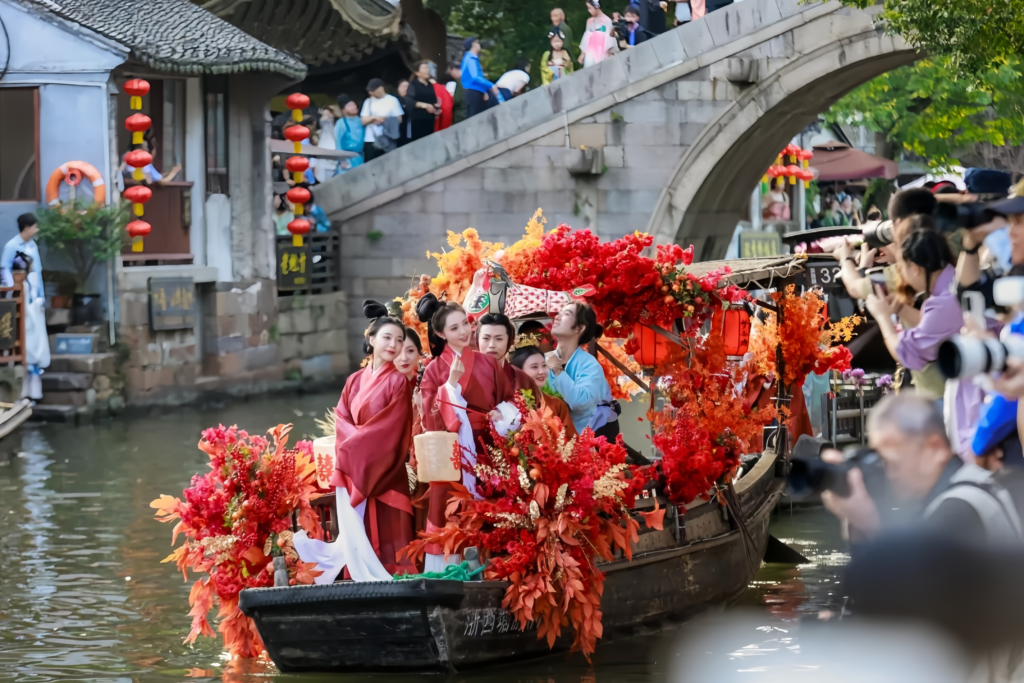
Clearly, contemporary youth have developed a strong sense of cultural confidence and identity with traditional Chinese culture—particularly Hanfu. As a result, more people who were once mere bystanders are now embracing and appreciating Hanfu.
Why Hanfu Is Spreading
Several factors are contributing to the rise of Hanfu, making it more than just a passing trend. First, there is a growing sense of cultural pride in China, which has become a significant driver behind the Hanfu movement. As the country experiences a cultural renaissance, there is an increasing desire to reconnect with its rich heritage. Hanfu, once confined to history books, is now being embraced as a symbol of Chinese identity and historical continuity.
For many, wearing Hanfu is not just about appreciating beautiful clothing; it’s a way of expressing pride in their cultural roots and preserving an essential part of China’s history. This growing national pride is particularly prominent among younger generations who want to reclaim and promote the cultural traditions that have shaped their country for thousands of years.
Secondly, the increasing visibility of Hanfu in media and popular culture has played a pivotal role in transforming it into a fashionable statement. Films, TV shows, and online platforms featuring Hanfu have captured the imagination of millions, presenting the garment as both a symbol of tradition and a modern fashion choice. The influence of period dramas, where characters are seen wearing intricately designed Hanfu, has sparked a renewed interest in the clothing, prompting people to wear it not only for special occasions but as part of their everyday lives.
The growth of online communities and social media platforms has also played a crucial role in promoting Hanfu, allowing enthusiasts to share their passion and showcase their creativity. The fusion of traditional styles with modern trends has led to innovative designs that make Hanfu more accessible and appealing to contemporary tastes. From stylish, simplified versions of classic garments to bold, contemporary adaptations, Hanfu is now a blend of history and modernity that speaks to both tradition and trendiness.
From “Niche” to “Mainstream”
Since 2003, when Zhengzhou electrical worker Wang Letian first wore Hanfu in public and caught the attention of the media, Hanfu-related news has become a recurring topic of discussion. Over the years, stories about Hanfu have captured the public’s imagination and sparked debate about its cultural significance.
- “A woman wearing Hanfu mistaken for a Japanese outfit and told to leave.”
- “A post-90s girl traveled to over 30 countries in Hanfu.”
- “An elderly man accidentally threw away his granddaughter’s 20,000-yuan Hanfu wedding dress as trash.”
These stories reflect the inevitable challenges Hanfu has faced on its journey from niche to mainstream.
In the early days, wearing Hanfu in public was mostly limited to passionate young culture enthusiasts who were drawn to the garment for its historical and cultural value. This was a time when Hanfu was primarily associated with cosplay, cultural events, and small gatherings of people who shared a deep appreciation for traditional Chinese clothing.
However, over the past decade, with greater cultural promotion, online communities, and social media platforms showcasing Hanfu, the garment has slowly transitioned into mainstream fashion. Iconic styles like the “Mamian skirt” (马面裙) have found their way into everyday wardrobes, breaking through initial resistance and being embraced by a more diverse and growing demographic.
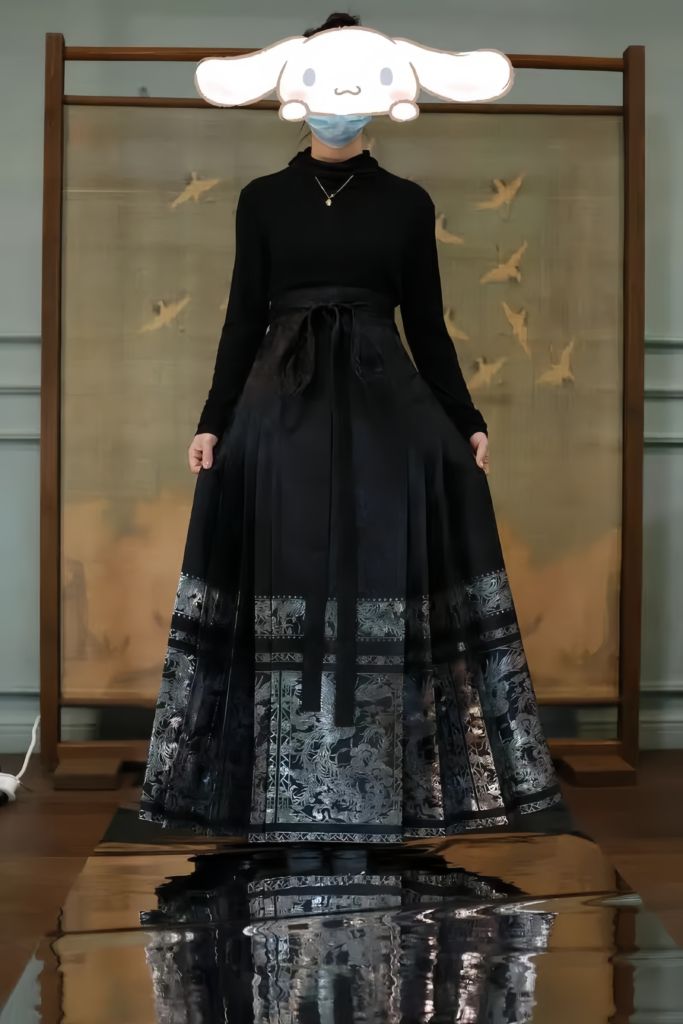
Today, Hanfu is not just an ancient garment but a symbol of cultural pride, and its presence in daily life reflects the broader “Hanfu craze” as it finds its place in contemporary society.
This November, Hanfu made an impressive mark at the Yangtze River Delta Cultural Expo with the premiere of the original Hanfu performance “Splendid Jiangnan” (锦绣江南). The event drew a large and enthusiastic audience, captivated by the beauty of traditional Chinese clothing and the rich cultural storytelling that accompanied it.
The performance showcased exquisite Hanfu garments, professional performances, and an immersive visual experience that highlighted the elegance of Hanfu, allowing the audience to appreciate its timeless beauty. This event is a prime example of how Hanfu has evolved from a cultural niche to a widespread “Hanfu cultural trend” that attracts not only traditionalists but also younger generations who are eager to reconnect with their heritage.
The success of this event serves as a testament to how Hanfu continues to spread, gaining recognition and appreciation across different cultural contexts and communities.
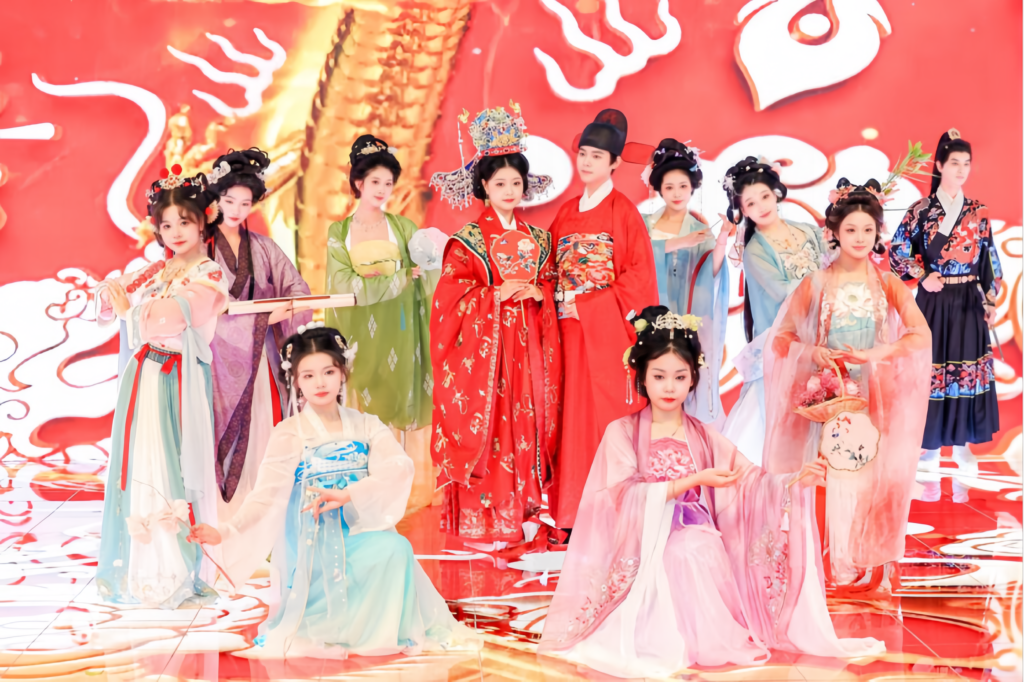
More Than Just a Trend
The widespread adoption of Hanfu is not about making it mandatory daily wear but rather about enhancing aesthetic appreciation, learning etiquette, and preserving traditional culture. Wearing Hanfu, whether at a cultural event, a photo shoot, or even a casual outing, provides a chance to connect with one’s heritage. It serves as an embodiment of China’s rich history and cultural values, allowing individuals to express their identity while embracing the beauty of tradition. This shift is part of the larger “Hanfu craze,” where enthusiasts seek not just fashion, but a deeper understanding and respect for the customs and rituals associated with the attire. This growing “Hanfu craze” highlights the deeper significance of rediscovering traditional Chinese culture in contemporary society.
The core essence of the “Hanfu craze” is people’s growing self-awareness, self-reflection, and confidence in Chinese heritage. As more people embrace Hanfu, they are not just participating in a cultural revival—they are reclaiming their cultural roots in an increasingly globalized world. This phenomenon reflects the broader “Hanfu cultural trend” that is spreading across generations. It speaks to a movement where traditional practices and values are being rediscovered and celebrated in modern times, with Hanfu playing a central role in this revival. Through this movement, individuals are fostering a greater sense of pride and unity within the Hanfu community.
The “Hanfu cultural trend” is now seamlessly blending into modern life, ensuring that Hanfu remains relevant, not just as a passing fashion trend, but as a lasting cultural phenomenon. From fashion-forward designs that reinterpret traditional styles to the growing presence of Hanfu in popular media and cultural events, Hanfu’s influence is expanding across generations. The “Hanfu craze” is no longer confined to historical reenactments or niche groups—it has become a mainstream cultural trend, bridging the gap between ancient traditions and modern creativity. The ongoing spread of Hanfu underscores how it has become a powerful symbol of both cultural pride and modern-day style.
Today, Hanfu culture is already integrated into daily life, from traditional Han-style weddings to fashionable modern Hanfu designs and historically accurate costumes in period dramas. Young people are incorporating Hanfu into their wardrobes for various occasions, whether it’s a cultural festival, a casual outing, or a formal event. This fusion of the old with the new reflects the dynamic nature of the “Hanfu cultural trend,” where the timeless elegance of the past meets the evolving tastes of the present. Through this, Hanfu continues to hold its place in contemporary life, not as a symbol of nostalgia but as a vibrant representation of China’s cultural renaissance.
Thus, there is no need to worry that the “Hanfu craze” is just a fleeting trend. This is not a temporary fascination with the past but rather a cultural revival, a confident era that celebrates its heritage. As long as people continue to embrace Hanfu, it will remain an enduring symbol of cultural pride and aesthetic beauty, woven into the fabric of modern life with every passing generation. The “Hanfu craze” is here to stay, marking a significant cultural shift that will continue to spread and evolve as part of the ongoing Hanfu cultural trend.


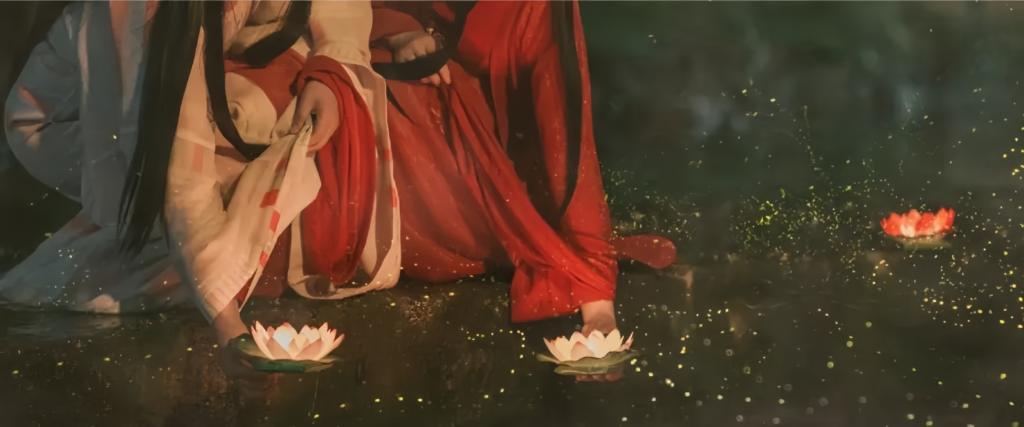


Responses